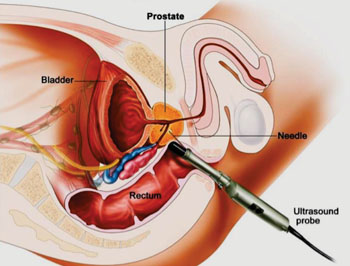Prostate Needle Biopsy Biomarker Predicts Tumor Aggressiveness
By LabMedica International staff writers
Posted on 11 Apr 2016
A new study demonstrates the ability to measure and evaluate biomarkers from ribonucleic acid (RNA) expression data obtained from prostate needle biopsies. The data demonstrate a high concordance in the genomic signatures between needle biopsy samples and post-prostatectomy tissue samples. Posted on 11 Apr 2016
The study showed that genetic information from prostate needle biopsy may be used to predict tumor aggressiveness and provided preliminary evidence that the Decipher score may be predictive of disease progression following biopsy as well as following prostate surgery and concordance in molecular information between prostate biopsy and surgery samples analyzed.

Image: Schematic diagram of a transrectal prostate biopsy (Photo courtesy National Cancer Institute).
Scientific collaborators from Cedars Sinai Medical Center (Los Angeles, CA, USA) and other institutions compared analysis of a total of 158 samples from 33 men, including pre-operative needle core biopsies and tissues obtained from radical prostatectomy. The identified 95% of transcriptomic features expressed in surgical samples were expressed in pre-surgery biopsy samples with a high expression correlation. The expression signature pattern yielded by Decipher Biopsy (GenomeDx Biosciences; Vancouver, BC, Canada) showed a high degree of correlation between the two sample types providing strong evidence of the utility of Decipher Biopsy in prostate needle biopsies.
Jeffry Simko, PhD, MD, a Professor of Clinical Pathology, said, “More than 800,000 men undergo prostate biopsy annually in the United States to identify prostate cancer, and this study increases confidence that reliable, quality genomic information can be obtained for those biopsies to better classify patient risk. Genomic biomarkers used by Decipher may help overcome current challenges of tumor heterogeneity and variability in staging of disease. Studies demonstrate that the Decipher score may be predictive of disease progression in diagnostic prostate needle biopsies and warrants a larger, adequately powered study to validate this observation.” The study will be published in the May 2016 issue of Journal of Molecular Diagnostics.
Related Links:
Cedars Sinai Medical Center
GenomeDx Biosciences














